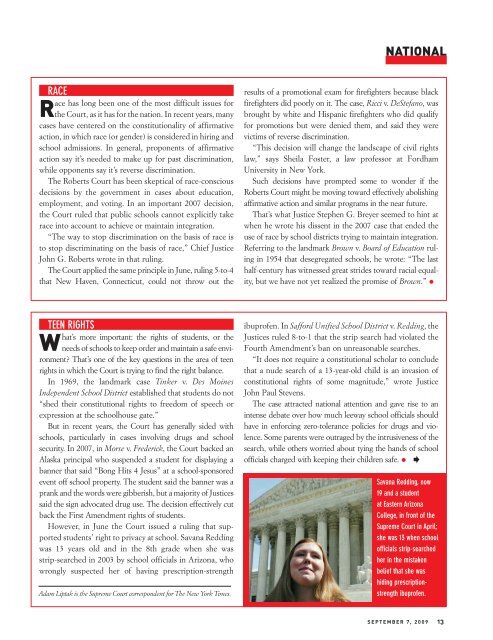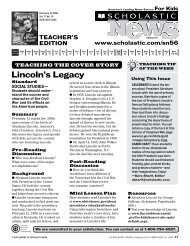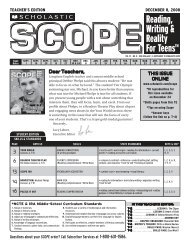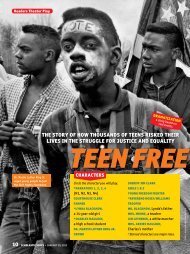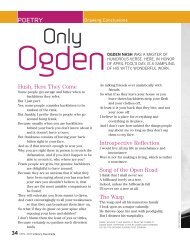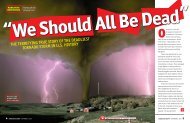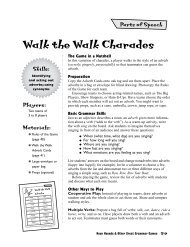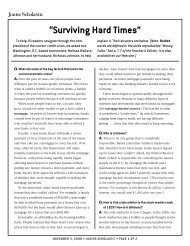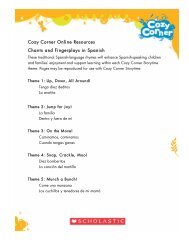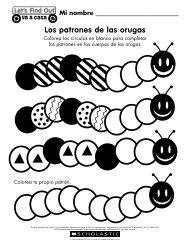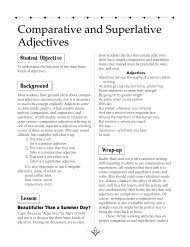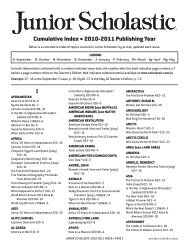3billion - Scholastic
3billion - Scholastic
3billion - Scholastic
You also want an ePaper? Increase the reach of your titles
YUMPU automatically turns print PDFs into web optimized ePapers that Google loves.
ace<br />
race<br />
has long been one of the most difficult issues for<br />
the Court, as it has for the nation. In recent years, many<br />
cases have centered on the constitutionality of affirmative<br />
action, in which race (or gender) is considered in hiring and<br />
school admissions. In general, proponents of affirmative<br />
action say it’s needed to make up for past discrimination,<br />
while opponents say it’s reverse discrimination.<br />
The Roberts Court has been skeptical of race-conscious<br />
decisions by the government in cases about education,<br />
employment, and voting. In an important 2007 decision,<br />
the Court ruled that public schools cannot explicitly take<br />
race into account to achieve or maintain integration.<br />
“The way to stop discrimination on the basis of race is<br />
to stop discriminating on the basis of race,” Chief Justice<br />
John G. Roberts wrote in that ruling.<br />
The Court applied the same principle in June, ruling 5-to-4<br />
that New Haven, Connecticut, could not throw out the<br />
teen riGhts<br />
w hat’s<br />
more important: the rights of students, or the<br />
needs of schools to keep order and maintain a safe environment?<br />
That’s one of the key questions in the area of teen<br />
rights in which the Court is trying to find the right balance.<br />
In 1969, the landmark case Tinker v. Des Moines<br />
Independent School District established that students do not<br />
“shed their constitutional rights to freedom of speech or<br />
expression at the schoolhouse gate.”<br />
But in recent years, the Court has generally sided with<br />
schools, particularly in cases involving drugs and school<br />
security. In 2007, in Morse v. Frederick, the Court backed an<br />
Alaska principal who suspended a student for displaying a<br />
banner that said “Bong Hits 4 Jesus” at a school-sponsored<br />
event off school property. The student said the banner was a<br />
prank and the words were gibberish, but a majority of Justices<br />
said the sign advocated drug use. The decision effectively cut<br />
back the First Amendment rights of students.<br />
However, in June the Court issued a ruling that supported<br />
students’ right to privacy at school. Savana Redding<br />
was 13 years old and in the 8th grade when she was<br />
strip-searched in 2003 by school officials in Arizona, who<br />
wrongly suspected her of having prescription-strength<br />
Adam Liptak is the Supreme Court correspondent for The New York Times.<br />
national<br />
results of a promotional exam for firefighters because black<br />
firefighters did poorly on it. The case, Ricci v. DeStefano, was<br />
brought by white and Hispanic firefighters who did qualify<br />
for promotions but were denied them, and said they were<br />
victims of reverse discrimination.<br />
“This decision will change the landscape of civil rights<br />
law,” says Sheila Foster, a law professor at Fordham<br />
University in New York.<br />
Such decisions have prompted some to wonder if the<br />
Roberts Court might be moving toward effectively abolishing<br />
affirmative action and similar programs in the near future.<br />
That’s what Justice Stephen G. Breyer seemed to hint at<br />
when he wrote his dissent in the 2007 case that ended the<br />
use of race by school districts trying to maintain integration.<br />
Referring to the landmark Brown v. Board of Education ruling<br />
in 1954 that desegregated schools, he wrote: “The last<br />
half-century has witnessed great strides toward racial equality,<br />
but we have not yet realized the promise of Brown.” •<br />
ibuprofen. In Safford Unified School District v. Redding, the<br />
Justices ruled 8-to-1 that the strip search had violated the<br />
Fourth Amendment’s ban on unreasonable searches.<br />
“It does not require a constitutional scholar to conclude<br />
that a nude search of a 13-year-old child is an invasion of<br />
constitutional rights of some magnitude,” wrote Justice<br />
John Paul Stevens.<br />
The case attracted national attention and gave rise to an<br />
intense debate over how much leeway school officials should<br />
have in enforcing zero-tolerance policies for drugs and violence.<br />
Some parents were outraged by the intrusiveness of the<br />
search, while others worried about tying the hands of school<br />
officials charged with keeping their children safe. •<br />
savana redding, now<br />
19 and a student<br />
at eastern arizona<br />
college, in front of the<br />
supreme court in april;<br />
she was 13 when school<br />
officials strip-searched<br />
her in the mistaken<br />
belief that she was<br />
hiding prescriptionstrength<br />
ibuprofen.<br />
September 7, 2009 13


